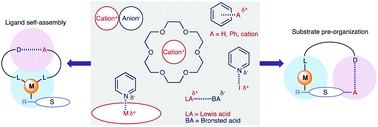Beyond hydrogen bonding: recent trends of outer sphere interactions in transition metal catalysis
Abstract
Homogeneous catalytic reactions are typically controlled by the stereoelectronic nature of the ligand(s) that bind to the metal(s). The advantages of the so-called first coordination sphere effects have been used for the efficient synthesis of fine chemicals relevant for industrial and academic laboratories since more than half a century. Such level of catalyst control has significantly upgraded in the last few decades by mastering additional interactions beyond the first coordination sphere. These so-called second coordination sphere effects are mainly inspired by the action mode of nature's catalysts, enzymes, and, in general, rely on subtle hydrogen bonding for the exquisite control of activity and selectivity. In order to span the scope of this powerful strategy to challenges that cannot be solved purely by hydrogen bonding, a variety of less common interactions have been successfully introduced in the last few years for a fine chemical synthesis. This review covers the latest and most exciting developments of this newly flourishing area with a particular focus on highlighting how these types of interactions can be rationally implemented to control the reactivity in a remote fashion, which is far away from the active site similar to what enzymes also do.



 Please wait while we load your content...
Please wait while we load your content...